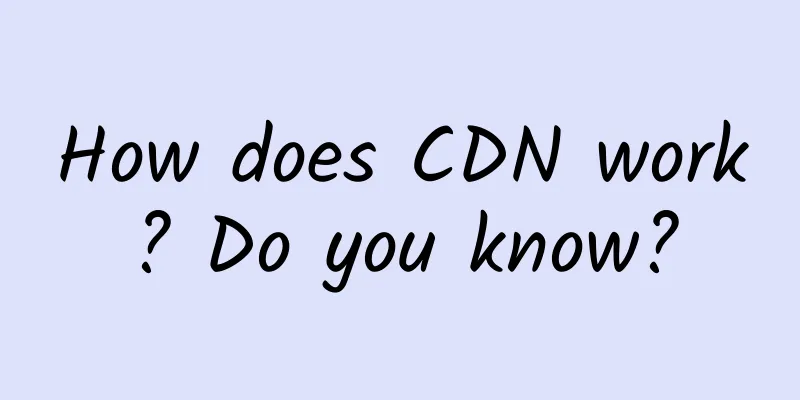TCP Sliding Window Principle Analysis

I. SummaryA few days ago, when I was sharing an article about network programming knowledge, a netizen sent me a private message asking "Can you write an article about the principle of TCP sliding window?" I didn't respond immediately at the time, but after checking various sources, I discovered that TCP is extremely complex, like a clear ditch that you thought was shallow, but when you step into it, it turns out to be unfathomable. Although I have summarized some technical knowledge related to network programming before and made some introductions to the TCP protocol stack, the descriptions were generally simple and I did not have a deep understanding. This article has largely filled the gap in my knowledge of computer networks. Without further ado, let’s get straight to the point! 2. TCP Data TransmissionIn the previous article, we learned that the TCP protocol can ensure reliable and error-free data transmission between computers on the network. For example, uploading files, downloading files, browsing web pages, etc. all benefit from it, and the actual application scenarios are very wide. The UDP protocol is also the dominant protocol along with the TCP protocol. Although the UDP protocol has higher transmission efficiency, it does not guarantee the correctness of data transmission and is slightly inferior to TCP. In fact, after years of development, the TCP protocol has become a standard protocol for achieving reliable data transmission. The so-called reliability means ensuring that data reaches the destination accurately, without duplication or delay. How does the TCP protocol achieve these characteristics? In fact, it is not easy to achieve reliable data transmission, because there are many abnormal situations to consider, such as data loss, disordered data order, network congestion, etc. If these problems cannot be solved, there is no way to talk about reliable transmission. In general, the TCP protocol achieves stable and reliable data transmission through mechanisms such as sequence numbers, confirmation responses, retransmission control, connection management, and window control. The following is the message format of TCP protocol. picture The TCP message segment consists of two parts: the protocol header and the data. The fixed part of the protocol header is 20 bytes, the header is the fixed part, and the option part follows. The following are the meanings of the various fields in the segment header:
URG (urgent): When it is 1, it indicates that the urgent pointer field is valid ACK (acknowledgement): When it is 1, it indicates that the confirmation number field is valid PSH (Push): When it is 1, the receiver should hand over this message segment to the application layer as soon as possible. RST (reset): When it is 1, it indicates that the TCP connection fails and the connection must be reestablished SYN (synchronization): used to synchronize sequence numbers when a connection is established FIN (termination): When it is 1, it indicates that the sender has finished sending data and requires to release the connection.
When TCP protocol is used to transmit data between computers, each connection needs to go through three stages: creating a connection, transmitting data, and releasing the connection. That is, before transmitting data, a logical connection is established between the sender and the receiver, then the data is transmitted, and finally the connection is disconnected. It ensures relatively reliable data transmission between the two computers. 2.1. Create a connectionBefore two devices are ready to transmit data, TCP will establish a connection. The stage of creating a connection requires a three-way handshake. The process is as follows: picture The detailed process is as follows:
After completing the above three handshakes, the reliability connection is established and data transmission can be carried out. 2.2. Release the connectionWhen the data transmission is completed, TCP will release the connection. The release of the connection requires four handshakes. The process is as follows: picture
After completing the above 4 waves, the connection is released. 2.3 Data transmission processThrough the above introduction, we can depict a simplified version of the TCP data transmission process, as shown in the figure below. picture The sequence number and confirmation response mechanism is one of the ways TCP achieves reliable data transmission and is also the most important cornerstone. However, in a complex network environment, data transmission may not be as smooth as described in the above figure. For example, if data packets are lost, TCP uses a retransmission mechanism to solve this problem. 3. Introduction to retransmission mechanismWhen the network is unstable, data packet loss is likely to occur. What retransmission methods does TCP use to solve the problem of data packet loss? Common retransmission methods are as follows:
3.1、Timeout retransmissionTimeout retransmission, as the name suggests, means setting a timer when sending data. When the specified time expires and no ACK confirmation message is received from the other party, the data will be resent. TCP will timeout and retransmit in the following two situations:
The key issue is how to set the timeout retransmission time. Let's first take a look at the normal data transmission process. picture RTT refers to the time required for data to be transmitted from one end of the network to the other end, that is, the round-trip time for a data packet to be sent. The timeout retransmission time is represented by RTO (Retransmission Timeout). What will happen if the timeout retransmission time is set too long? As shown in the figure below picture What will happen if the timeout retransmission time is set too small? As shown in the following figure picture After analyzing all the way, we can draw the following conclusions:
Therefore, we can draw a conclusion that the timeout retransmission time cannot be set too large or too small, and must be calculated accurately. Taking the Linux operating system as an example, the RTO calculation process is as follows!
picture Where SRTT is the smoothed RTT, and DevRTR is the difference between the smoothed RTT and the latest RTT. Under Linux, α = 0.125, β = 0.25, μ = 1, ∂ = 4 are usually used. The actual calculated retransmission timeout RTO value should be slightly larger than the round-trip RTT value of the message. If the data that has been retransmitted times out again and needs to be retransmitted, TCP's strategy is to double the timeout interval. That is to say, every time a timeout retransmission occurs, the next timeout interval will be set to twice the previous value. Multiple timeouts indicate a poor network environment and frequent retransmissions are not recommended. 3.2 Fast RetransmitAlthough timeout retransmission can solve the problem of data packet loss, the timeout retransmission time may sometimes be long. Is there a faster retransmission method? Fast retransmission is used to make up for the problem of too long time in the timeout retransmission mechanism. Simply put, fast retransmit does not drive retransmission by time like timeout retransmission, but drives retransmission by number of times. When the number of duplicate ACKs received for a message reaches a certain threshold (usually 3), TCP will check for lost segments and retransmit them before the timer expires. The general working method can be described as follows! picture In the figure above, the sender sends 1, 2, 3, 4, and 5 copies of data to the receiver. The general execution process is as follows:
Therefore, the working method of fast retransmission is that when the number of identical ACK messages received reaches a threshold, which is 3 by default, the lost segments will be retransmitted before the timer expires. The fast retransmit mechanism makes up for the problem of too long time in the timeout retransmission mechanism, but it still faces another problem, that is, when retransmitting, should it retransmit the previous one or retransmit all packets? For example, in the above example, should Seq2 be retransmitted, or should Seq2, Seq3, Seq4, and Seq5 be retransmitted? Depending on the TCP implementation, both of the above situations are possible. 3.3 SACK methodIn order to solve the problem of not knowing which TCP packets to retransmit, genius engineers came up with the SACK method, the full English name: Selective Acknowledgment, also known as selective confirmation. The specific implementation is to add a SACK in the TCP header option field. The receiver can send the cached data map to the sender, so that the sender can know which data has been received and which data has not been received. Knowing this information, only the lost data can be retransmitted. As shown in the figure below, when the sender receives the same ACK confirmation message three times, the fast retransmission mechanism will be triggered. Through the SACK information, it is found that only the data segment 200~299 is lost, and the lost segment will be retransmitted to improve the reliability and efficiency of data transmission. picture It is important to note that if you want to support the SACK mechanism, both the sender and the receiver must support it. In the Linux operating system, developers can enable this feature through the net.ipv4.tcp_sack parameter (enabled by default after Linux 2.4). 3.4 Duplicate SACK methodFinally, let’s talk about the Duplicate SACK method, also known as D-SACK. This method mainly uses SACK and ACK to tell the sender which data has been received repeatedly to prevent TCP from repeatedly retransmitting. We use a case to introduce the role of D-SACK, such as the scenario of ACK packet loss, as shown in the figure below! picture Process analysis:
The benefit of using the D-SACK method is that it allows the sender to know whether the sent packet is lost or the ACK packet responded by the receiver is lost, and then decide whether to continue to resend the packet. In Linux operating system, you can use the net.ipv4.tcp_dsack parameter to enable/disable this feature (enabled by default after Linux 2.4). 4. Introduction to Sliding WindowIn the above, we have introduced the data transmission mechanism of the TCP protocol. After a connection is established between two computers, data can be transmitted. TCP must make a confirmation response every time it sends a data packet. When the previous data packet receives the response, the next one is sent to ensure reliable data transmission. picture Although this transmission method is reliable, it also has obvious disadvantages. The efficiency of data transmission is very low. It is like you are talking to someone on the phone now. You say a sentence, and you can only say the next sentence after the other party replies to you. This is obviously unrealistic. To solve this problem, TCP introduced a sliding window, which allows multiple data packets to be sent into the window at one time without waiting for the recipient's confirmation response in sequence. Even if the round-trip time is long, it will not reduce the data transmission efficiency. So what is a sliding window? Let's take a toll booth on a highway as an example to make an analogy. Anyone who has been on a highway should know that there is an entrance toll booth and an exit toll booth on the highway. TCP is the same, except that there is a sender sliding window at the entrance and a receiver sliding window at the exit. picture For the sender sliding window, we can regard the data packets as vehicles and classify their states:
Similarly, for the receiver sliding window, we can also regard the data packets as vehicles and classify their states:
Through the above description, I believe everyone has a preliminary understanding of the sliding window. In the entire data transmission process, light transmission is similar to a highway, and the sliding window is similar to a toll station. Through the toll station, appropriate flow control of vehicles can be achieved to prevent congestion on the highway. The sliding window has the same effect. 4.1. Sender’s Sliding WindowThe figure below is an example of the sliding window of the sender, which is divided into four parts according to the processing situation. The dark blue box is the sending window and the purple box is the available window. picture Meaning:
When the sender sends all the data at once, the size of the available window becomes 0, indicating that the available window is exhausted and no more data can be sent before receiving the ACK confirmation from the receiver. picture After receiving the ACK confirmation response for the previously sent data 32~36 bytes, if the size of the sending window has not changed, the sliding window moves 5 bytes to the right, because 5 bytes of data have been acknowledged, and then 52~56 bytes become the available window again, so the 5 bytes of data 52~56 can be sent subsequently. picture How does the program accurately control the sender's window data? The TCP sliding window scheme uses three pointers to track bytes in each of the four transmission categories. Two of the pointers are absolute pointers (referring to specific sequence numbers) and one is a relative pointer (requires an offset). picture Meaning:
4.2. Sliding Window of the ReceiverNext, let's look at the receiving side's sliding window. The receiving window is relatively simple and is divided into three parts based on the processing situation. picture Meaning:
The three receiving parts are divided using two pointers:
V. SummaryCompared with the traditional data transmission model of sending a packet, waiting for confirmation and then sending the packet again, the sliding window transmission method of sending batches of packets at one time and then waiting for confirmation can significantly improve data transmission efficiency. The entire transmission process can be described by the following figure. picture Even if the ACK 600 confirmation message in the above figure is lost, it will not affect data transmission, because it can be confirmed by the next confirmation response. As long as the sender receives the ACK 700 confirmation response, it means that the receiver has received all the data before 700. This confirmation response mode is called cumulative confirmation or cumulative response. In the above, we mentioned that the sliding window has a very important parameter, which is the window size. Usually, the size of the window is determined by the receiver. The receiver tells the sender how much buffer it has available to receive data to prevent the receiver from sending too much data and being unable to process it, which would trigger the sender's retransmission mechanism and lead to unnecessary waste of network traffic. By controlling the window size, we can prevent the sender's data from exceeding the receiver's available window, which is often called flow control. In addition, computer networks are in a shared environment, and network congestion is inevitable. When network congestion occurs, the means of flow control are very limited. If the network is congested, the sender continues to send a large number of data packets, which may cause data packet delays and loss. At this time, TCP will retransmit the data, which will cause a heavier burden on the network, resulting in greater delays and more packet loss, which may enter a vicious cycle. Therefore, TCP cannot ignore what happens on the network. When the network is congested, TCP needs to reduce the amount of data sent to prevent the sender's data from filling the entire network. We call this behavior congestion control. Regarding the implementation of flow control and congestion control, since the article is too long, we will explain it in detail in the next article. This article organizes the knowledge shared by some excellent netizens. Special thanks to the author Xiaolin Coding for sharing the illustrated TCP sliding window article, which provided great knowledge help. At the same time, combined with my own understanding, I discussed the principle of TCP sliding window in a more comprehensive way. I hope it will be helpful to everyone. |
<<: The role of fiber in integrated infrastructure development
>>: How 5G and IoT will revolutionize the world
Recommend
Germany approves Huawei 5G, says it will remain open to competing technologies
After successively losing important markets such ...
Summary information: CUBECLOUD/Duoxiantong/CYUN/PIGYun/Ouluyun/VoLLcloud/Hongsu Technology
July and August are the summer vacations, and man...
WeChat tests voice progress bar function, netizens: finally it's here
The video progress bar was once added by Tencent ...
CloudServer: $12/quarter-single core, 4G memory, 30G NVMe disk, 5TB/10Gbps New York data center
CloudServer is a foreign hosting company founded ...
Which Ethernet (Cat5, Cat5e, Cat6, Cat6a) cable should I use?
Not all Ethernet cables are created equal. What a...
China Telecom responds to "chip shortage": there is a plan and it will not affect 5G deployment
Yesterday, China Telecom announced its full-year ...
GSMA Liu Hong: Who will build the 5G private network? Let the operators do it
[[383535]] 5G has the characteristics of high spe...
6G Internet of Things: From the Internet of Everything to the Intelligent Internet of Everything, opening up smart life, smart production and smart society
At the 6G Internet of Things Forum of the 4th Chi...
Game lag? Be careful to use the wrong WiFi frequency at home
When you use WiFi at home to play games, you alwa...
Tencent Cloud Lighthouse Care, help you get up to 200 yuan in coupons
Tencent Cloud recently launched a lightweight wor...
Meituan second interview: TCP's four waves, can it be reduced to three?
Hello everyone, I am Xiaolin. I have posted this ...
An article to show you how to use Nginx as a proxy for WebSocket
Hello everyone, I am Xiao Jiang. The previous art...
Countries are launching alliance strategies to compete for the right to formulate 6G standards
As many countries have suffered losses in the pac...
Exclusive for newcomers of Hengchuang Technology: Hong Kong cloud server is 28 yuan for the first month/220 yuan for the first year, and the monthly payment of Hong Kong server is 900 yuan
Domestic cloud service providers such as Alibaba ...
ZJI: Hong Kong Kwai Wan server saves 300 yuan per month, E3/E5 model monthly payment starts from 450 yuan
This month, ZJI launched a new model A in Kwai Wa...









